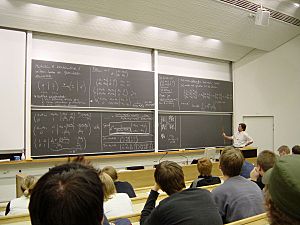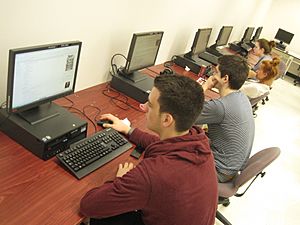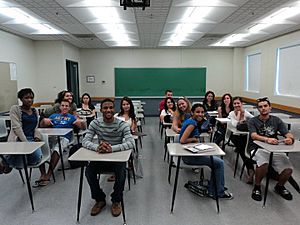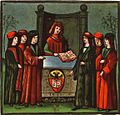Student facts for kids
A student is someone who is learning. This can be a child, a teenager, or an adult. Students usually go to a school, college, or university. Another common word for a student, especially a younger one, is a pupil. Students often learn from a teacher or a lecturer.
Contents
How School Works Around the World
School systems can be different in various countries. Let's look at how students learn in different parts of the world.
Learning in Asia
Brunei's School System
In Brunei, students go through several stages:
- Primary School: Years 1 to 6
- Secondary School: Years 7 to 11
- High School (also called Sixth Form Centers): Years 12 to 13
- Colleges: Pre-University to Diploma levels
- University: Undergraduate, Postgraduate, and Professional studies
Primary school takes six years, and secondary school takes five years. After these, students can choose to go to high school, college, or start working. Many then move on to university programs.
Education in Pakistan
Pakistan has a 12-year school system divided into three main parts:
- Primary school: 5 years
- Secondary school: 3 years
- Higher Secondary school: 2 years
After this, students can attend college or pre-university college for 2 years.
Iran's School Journey
Iran's 12-year school system also has three stages:
- Elementary school: 5 years
- Junior high school: 3 years
- High school: 3 years
After high school, students get a diploma. They can then take a special university entrance exam called Konkoor. This exam is held every year by the National Organization of Education Assessment.
School Life in Australia
In Australia, children usually start primary school after their fifth birthday. Before this, they might go to kindergarten or preschool, which are not required.
Primary school usually goes from 'Year One' to 'Year Six'. After primary school, students begin secondary school, also known as high school. This starts in 'Year Seven' and continues until 'Year Twelve'. Students in Year Eight to Ten are sometimes called juniors, while Year Eleven and Twelve students are called seniors.
After Year Twelve, students can go to university or TAFE (technical and further education) for higher learning. The general term for all students, from primary to university, is 'students'.
New Zealand's Education Path
In New Zealand, children attend kindergarten or pre-school from ages three to five. They then start primary school, called 'Year One', at age five.
- Years One to Six: Primary School
- Years Seven and Eight: Intermediate School
- Years Nine to Thirteen: Secondary School or College
Children in primary school are known as Pupils. Those in intermediate and secondary school are called Students. Year Thirteen is not required, and many students finish school after Year Twelve.
European School Systems
Finland's Education Stages
In Finland, a student is called "opiskelija" (for university students). Children in required education are called "oppilas."
- "Esikoulu" (preschool): Optional, attended at age six.
- "Peruskoulu" (basic school): Required, starts at age seven. This includes "alakoulu" (years 1-6) and "yläkoulu" (years 7-9).
After "peruskoulu," most students go to "lukio" (high school) or "ammattikoulu" (Vocational School). At this point, they become "opiskelija." To attend a university, students must complete this second level of education.
Germany's Student Terms
In Germany, the word "student" is only used for those attending a university. First-year university students are often called Ersties ("firsties"). For school students, different terms are used:
- Schüler or Schülerin: General term for a person going to school.
- Gymnasiasten: Students attending a university-prep school.
- Hauptschüler or Realschüler: Students attending other types of schools.
- Abiturienten: Students who graduate with the Abitur (a high school diploma).
Ireland's School Journey
In Ireland, pupils start with national school:
- Junior infants, senior infants, first class, and second class (ages 5–8).
They then move to primary school:
- Third class to sixth class (ages 9–12).
After primary school, pupils go to secondary school:
- Junior cycle: First year to third year (ages 13–15).
At the end of third year, students take the Junior Certificate exam.
- Transition year (optional): Fourth year (usually age 16). Students explore other activities to help their personal and social growth. This year helps them move from dependent learning to more independent learning.
- Senior cycle: Fifth year and sixth year (ages 16–19).
At the end of sixth year, students take the Leaving Certificate exam. This exam helps them get into higher education using a points system.
At university, new students are often called "freshers" or "first years." The first week of university is called "Freshers' Week" or "Welcome Week." A student in their final year before graduating is called a "finalist."
Sweden's Student Definitions
In Sweden, only those studying at university are called students (student). Finishing upper secondary school (gymnasium) is called ta studenten ("to take the student"). However, after graduating, they are no longer a student unless they enroll in university. For younger students, the word elev is used. The general term for anyone studying is studerande.
United Kingdom's School Terms
In the United Kingdom, "student" traditionally means someone at university. Children in school are called "pupils" or "schoolchildren." However, the American use of "student" for all ages is becoming more common.
In England and Wales:
- Primary school: Optional "nursery" year, then reception, followed by "year one" to "year six."
- Secondary school: Starts at "year 7" (ages 11–12) and goes up to "year 11."
- Sixth form: After year 11, teenagers (ages 16-18) attend "sixth form" (years 12 and 13) for further education. They might go to university after year 13.
In Scotland:
- Pupils take Highers exams at the end of fifth year (ages 16–17) to get into university. Many stay for a sixth year to gain more qualifications like Advanced Highers.
At universities in the UK, new students are informally called "freshers" or "first years."
North American Education Systems
Canada's Learning Stages
Education in Canada is managed by each province. The system is usually divided into primary, secondary, and post-secondary education.
- Grades 1 to 12: Numbered grades, often starting with kindergarten (optional).
- Elementary school: Usually Kindergarten to grade 7.
- Middle school or junior high: Grades 6 to 8.
- High school: Grades 9 to 12.
In Quebec, the system is a bit different:
- École primaire (primary school): Grades 1-6.
- École secondaire (secondary school): Secondaries I-V (equivalent to grades 7-11).
After high school (grade 11), students can go to a three-year college program or a two-year pre-university program before university.
In Canada, a "college" is different from a "university." Colleges focus on practical skills for jobs, while universities focus on academic careers. University students are usually called first, second, third, or fourth-year students.
United States School System
In the United States, the first official year of schooling is kindergarten. Before that, many public schools offer "preschool" programs. There are 12 years of required schooling.
- Grades 1-8: Students are called "1st graders," "5th graders," etc.
- High school (grades 9-12): Students have special names:
* 9th grade: Freshman * 10th grade: Sophomore * 11th grade: Junior * 12th grade: Senior
These terms are also used for college students. If a student takes longer than four years to graduate, they might be called a "super senior."
Graduate Students
A Graduate student is someone who continues their education after getting a first degree. Examples include law school, medical school, or veterinary school. They earn degrees like a Master’s degree or a Doctorate.
Vocational School
Students at a vocational school learn skills for specific jobs. These programs are usually shorter than four-year degrees, often lasting 12–24 months. They focus on practical skills needed for a career.
Jamaica's Education Stages
In Jamaica, children often start school at age two in basic school or kindergarten.
- Primary or preparatory school: Ages five or six for six years.
- Secondary school: After primary school. Some students finish after five years (11th grade) at age sixteen.
Some students then go to 6th form (12th and 13th grade) before university or college, or they enter the working world.
Mature Students
A mature student is an adult who goes back to tertiary education (university or college). They are usually at least 21–23 years old when they start and have been out of school for at least two years. This can include people who haven't been in school for many years or those without a secondary education.
Related pages
Images for kids
See also
 In Spanish: Estudiante para niños
In Spanish: Estudiante para niños











